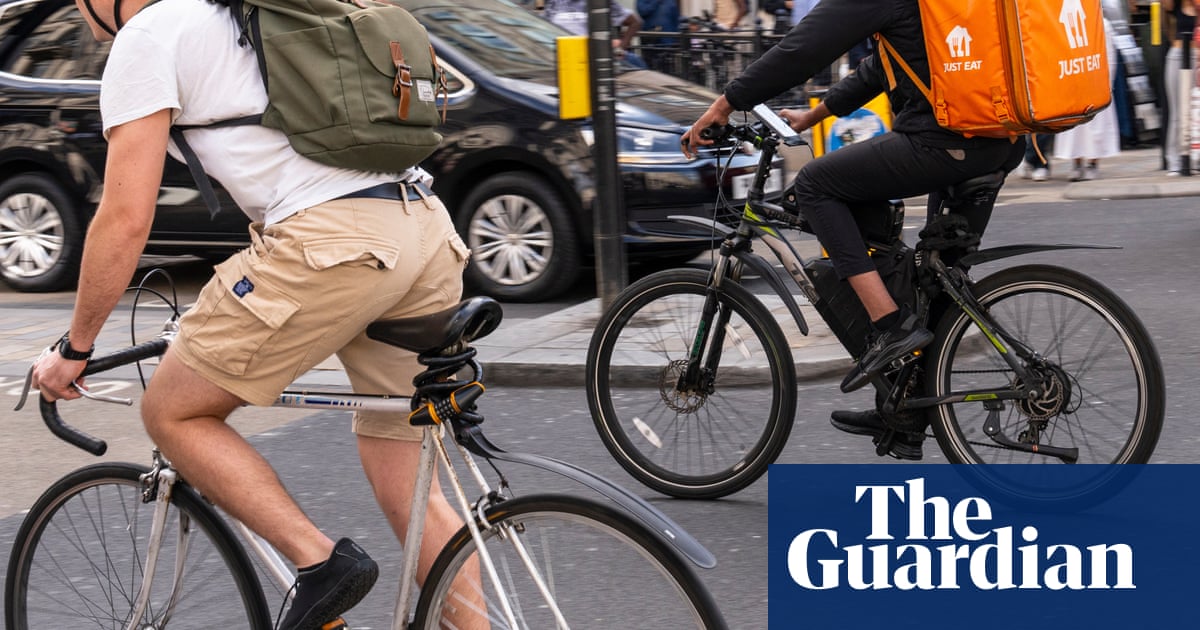It’s 8am in Clapham, the area of south-westLondonwhere young professionals and well-off homeowners are crammed into 2 sq miles of buzzy high streets, a leafy common and rows of terraced houses.
The popularity of the neighbourhood lies in its proximity to the city centre. A 4-mile hop to central London makes for an easy journey to work, especially for one kind of commuter: cyclists.
On the morning we visit Clapham High Street, at the height of rush hour, their presence is immediate.
In every direction bikes are weaving through traffic, filtering through busy roads in stops and starts. Drivers shout, horns blare and cars cut across each other. Adding to the sense of chaos are pedestrians who step off pavements without looking up from their phones. Near misses are common.
At the traffic lights, cyclists, many of them ebike riders with no helmets, zoom through red lights as if they’re not there. Some swerve in and out of bike lanes; one speeds up the wrong side of the road, narrowly avoiding a bus.
If the scene looks dangerous, statistics on collisions involving bikes suggest it is. This is the stretch of road in Great Britain where the most accidents involving cyclists have happened since 2020.
We visited the junction as part of a Guardian investigation into the safety of roads inEngland, Wales and Scotland. From 2020-23, there were 23 accidents involving cyclists reported to emergency services at the junction where Clapham High Street meets Gauden Road and Lenden Terrace.
One pedestrian said crossing the road had become increasingly frightening because cyclists ran red lights, particularly since the arrival of ebikes. “Cyclists put the fear of death into pedestrians now. They jump lights, they go on the pavement, they go counter to the traffic. It’s awful,” she said.
On the day we visit there are more law-abiding cyclists than those running red lights or cutting in front of cars. But during the observation period, a bike could be seen hurtling through a red light once every 90 seconds on average.
Simon Munk, the head of campaigns and community development atLondon Cycling Campaign, said junctions could be particularly risky for cyclists even where there were cycle lanes, as there are at the Clapham junction.
“A hugely high proportion of serious and fatal collisions happen at junctions for people cycling and so junctions are the spot where danger is at its most intense.”
Road design also played a big part. “Some junctions are almost designed in a way that creates conflict by introducing too many traffic movements across the cycle lanes,” he said. This meant any benefits of the designated lanes “completely disappear”.
Kyle Linch, a chef in Mayfair, said he regularly saw cycling accidents around Clapham. “I saw one girl fall off her Lime [bike] yesterday. These two cars came out of nowhere,” he said. “The traffic’s always mental so it’s not that surprising. I definitely wouldn’t say it’s safe.”
The popularity of ebikes undoubtedly contributes to the congestion on the road on the morning of our visit. The dockless bicycles whizz around in all directions, irking even other cyclists.
One commuter riding their own bike at the junction said: “There’s a lot of cycle lanes and I think drivers are quite cautious.
Sign up toFirst Edition
Our morning email breaks down the key stories of the day, telling you what’s happening and why it matters
after newsletter promotion
“I have heard of some horrific accidents and know people who have been hit. The ebikes seem to be the worst – running red lights, no helmets – and perhaps that’s because most of the people who ride them have less experience.”
For campaigners who want to encourage people to take up cycling, the focus on accident data and dangerous riding is unhelpful. Duncan Dollimore, the head of campaigns atCyclingUK, a charitable membership organisation, said the statistics did not capture the experience of cycling.
“Cycling is not an unsafe activity, in fact it’s statistically safe,” said Dollimore. “But that’s not how it feels to many people.”
Making the roads safer for cyclists would help to overcome that perception, he said. “The more protection and coherence and separation of infrastructure there is, the more people are likely to cycle, and do so safely.”
For the Clapham High Street commuters, good news may be at hand. Helen Cansick, Transport for London’s head of healthy streets investment, said changes were planned for this summer.
“We are committed to making changes across the capital so that people can travel safely, whatever mode of transport they choose,” she said.
A spokesperson for Lime said the rental company supported the TfL and London councils’ investment in cycling infrastructure. “Cyclists running red lights not only endanger themselves and others, but also undermine public confidence in cycling as a safe, sustainable mode of transport,” they said.
“Through regular rider communications, training programmes and penalties for dangerous behaviour, we work to educate riders and encourage safer cycling on our roads.”
